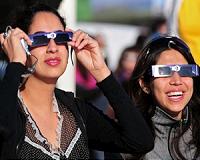 |
Athens, Greece (UPI) Jan 4, 2011 Sky watchers in Europe, northern Africa and the Middle East observed a partial solar eclipse Tuesday, the first of the New Year, astronomers said. The eclipse was partially visible in the greater Athens area, Greek news agency ANA-MPA reported. At the Athens Planetarium, members of the Hellenic Astronomical Society and amateur astronomers set up telescopes and were on hand to explain the phenomenon to parents and children gathered to view the eclipse. The eclipse began in Athens shortly before 9 a.m. local time, peaked at about 10:20 a.m. and was finished at noon, ANA-MPA reported. Observers in Poland reported the eclipse, which started at 8:14 a.m. local time, obscured 80 percent of the solar disc, Radio Poland reported. Watchers in Serbia witnessed the maximum coverage of the sun's diameter at 9:51 a.m., when 85.5 percent of the sun was in the shadow of the moon, Serbian news agency Tanjug reported.
earlier related report In Moscow, where the eclipse covered up to 81 percent of the sun, hazy clouds masked the sun in some areas, but enthusiasts gathered to view the eclipse from the Sparrow Hills viewpoint. In the northwestern city of Saint Petersburg, the sun was expected to be obscured by 84.6 percent, with thick clouds standing in the way. In Kazakhstan's capital of Astana, where the sun was obscured by up 53 percent, the eclipse was not visible due to clouds. Rare snowfall also covered the sun in Tashkent, the capital of the Central Asian republic of Uzbekistan. In Dushanbe, the capital of Tajikistan, the sun shone brightly and some residents tried to view the eclipse through photographic film, but complained that they could not see anything. The eclipse only covered the sun by up to 30 percent, the director of the the national institute of astrophysics, Khursand Ibodinov, told AFP. "Only specialists are able to observe this through telescopes.
earlier related report The first solar eclipse will take place on January 4. It will begin at 06:40 GMT and will be visible from Europe, the Middle East and Northern Africa. At maximum eclipse in northern Europe, the Moon will cover 86 percent of the Sun's diameter. The next solar eclipse will occur on June 1. Residents of the Russian Kolguyev island in the Barents Sea will have a chance to observe the Moon covering 60 percent of the Sun's diameter. The eclipse will also be visible from the eastern Arctic, northern Canada, the Kamchatka peninsula and other regions of Russia's Far East. On June 15, a total moon eclipse will take place, visible from India, the Middle East, Africa and southern Europe. Soon after it, another solar eclipse will occur, but this time the Moon will cast its shadow on less then 0.1 percent of the Sun. On November 25, the Moon will cover a total of 90.4 percent of the Sun's diameter, but the eclipse will be visible only from Antarctica and its surrounding seas. Residents of the entire Eurasia, as well as of Australia and the north-western part of North America will have a chance to observe the second and the last total moon eclipse in 2011 on December 10.
Source: RIA Novosti
Share This Article With Planet Earth
Related Links Solar and Lunar Eclipses at Skynightly
 Four Solar, Two Moon Eclipses To Take Place In 2011
Four Solar, Two Moon Eclipses To Take Place In 2011Moscow, Russia (RIA Novosti) Jan 04, 2011 Earthlings will have a chance to observe four solar and two total moon eclipses in 2011. The first solar eclipse will take place on January 4. It will begin at 06:40 GMT and will be visible from Europe, the Middle East and Northern Africa. At maximum eclipse in northern Europe, the Moon will cover 86 percent of the Sun's diameter. The next solar eclipse will occur on June 1. Resident ... read more |
|
| The content herein, unless otherwise known to be public domain, are Copyright 1995-2010 - SpaceDaily. AFP and UPI Wire Stories are copyright Agence France-Presse and United Press International. ESA Portal Reports are copyright European Space Agency. All NASA sourced material is public domain. Additional copyrights may apply in whole or part to other bona fide parties. Advertising does not imply endorsement,agreement or approval of any opinions, statements or information provided by SpaceDaily on any Web page published or hosted by SpaceDaily. Privacy Statement |